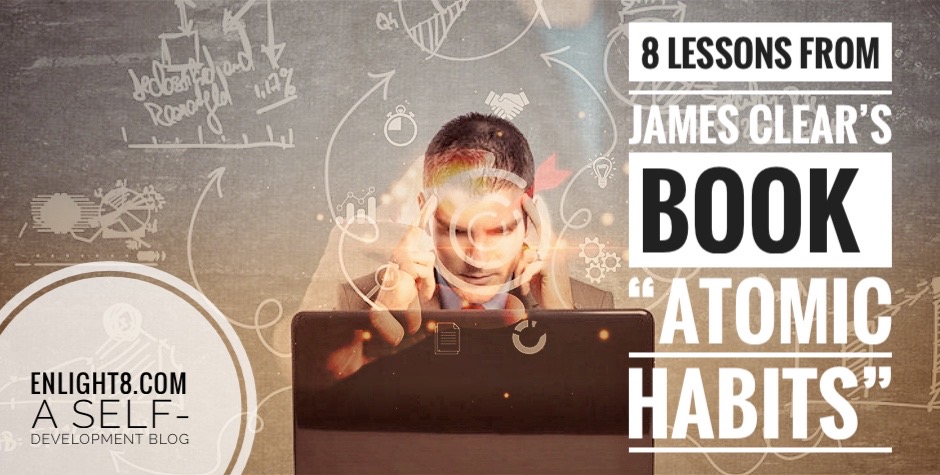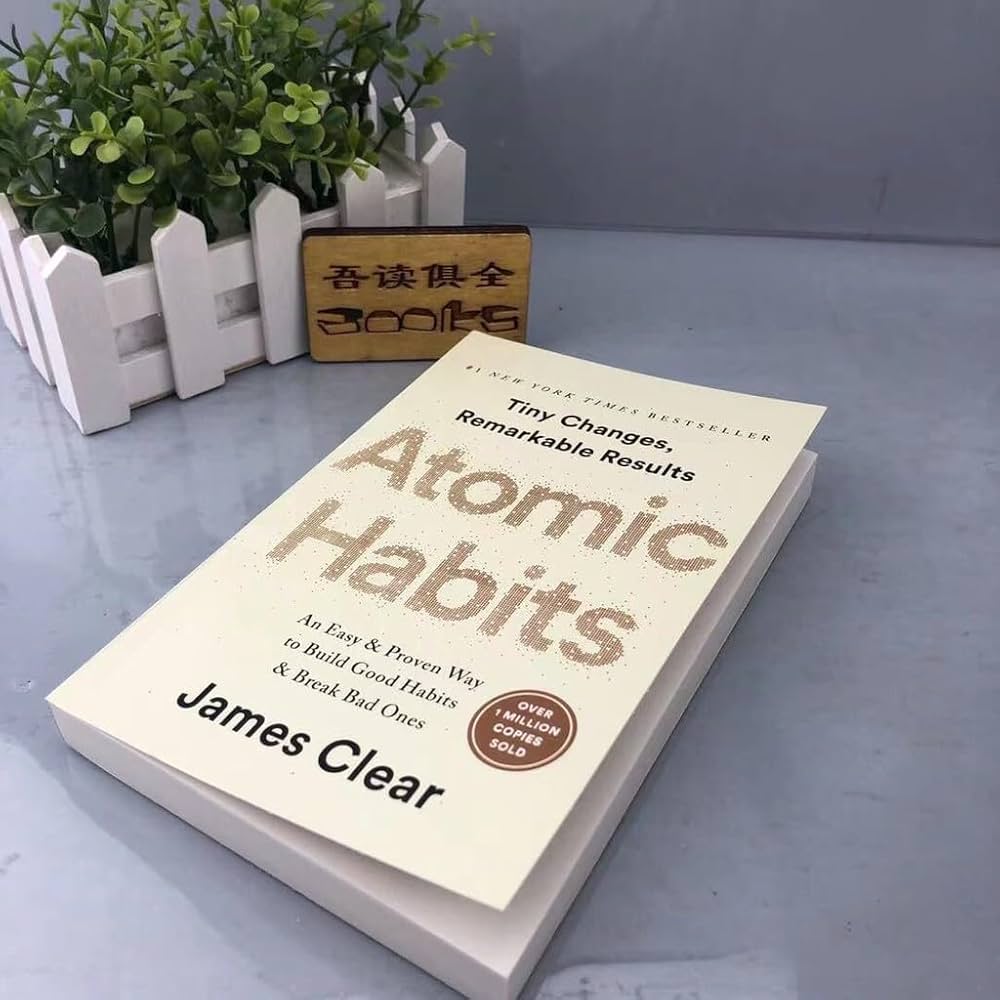
8 Lessons from James Clear’s book Atomic Habits
I am reading James Clear’s “Atomic Habits” as the first book I want to finish this year. The book presents a compelling idea about how small daily habits can significantly change our lives.
What if making significant changes in our lives didn’t require drastic measures but could come from making tiny, consistent daily efforts? Clear explains that focusing on becoming just 1% better daily can achieve excellent results.

The book contains practical strategies and helpful tips for developing positive habits and breaking free from negative ones. In today’s world, where people often look for quick fixes, the lessons in “Atomic Habits” remind us that small, steady actions can lead to impressive results in the long run.
Here are eight essential lessons from the book.
1. Small Changes Lead to Big Results
Aiming for tiny, incremental improvements, even as small as just 1% better each day, can lead to significant progress. This idea is based on compounding, where small changes can result in substantial advancements over a more extended period. When we focus on improving each day, we break down our larger goals into manageable steps. This approach allows us to progress steadily without feeling overwhelmed by the bigger picture.
Setting a goal to improve by 1% encourages us to develop a habit of continuous improvement. Instead of making drastic changes all at once, which can often lead to frustration and setbacks, we can adopt small, sustainable changes. Over time, these small efforts can lead to impressive results. This method emphasizes that it’s not always about making big leaps but rather about the consistency of small actions.
We often find that our motivation increases by dividing our goals into smaller, achievable chunks. Each small success boosts us, encouraging us to keep going. This method can be beneficial when working on long-term projects or personal growth. When we view our efforts as habits to cultivate, the process becomes more enjoyable and sustainable. Aiming for 1% improvement daily can create a powerful ripple effect, transforming our lives one small step at a time.
2. Identity Shapes Behavior

In his book “Atomic Habits,” James Clear explains how identity significantly influences behavior. Instead of focusing on specific goals like “I want to lose weight” or “I want to run a marathon,” he suggests a more assertive approach: shift your mindset to think, “I am a healthy person” or “I am a runner.”
When you change how you see yourself, your actions align with that new identity. For example, if you identify as healthy, you’re more likely to make choices that reflect that belief, like eating nutritious foods and exercising regularly. This shift helps habits stick because they become part of who you are rather than just tasks you must complete.
Clear emphasizes the importance of small, incremental changes, which he calls “atomic habits.” When consistently practiced, these tiny changes lead to significant transformations over time. Building your identity can create a stronger foundation for your habits.
In summary, work on changing your identity instead of just setting goals. This way helps make your desired behaviors feel more natural and sustainable. When you embrace the idea of being a healthy person or a dedicated student, your daily habits will begin to reflect that identity, leading to lasting success.
3. The Habit Loop: Cue, Craving, Response, Reward
In “Atomic Habits,” Clear presents a powerful concept called the Habit Loop, which consists of four main parts: Cue, Craving, Response, and Reward. Understanding this loop can help us build better habits and break bad ones.
- Cue: This is the trigger that starts the habit. It could be anything in your environment, like seeing a running shoe that reminds you to exercise or hearing an alarm that nudges you to study. The key to creating good habits is to make these cues evident and easy to notice. For instance, placing your book on your pillow can remind you to read before bed if you want to read more.
- Craving: This is the desire or motivation to perform the habit. Our cravings are often tied to rewards; we crave the feeling or outcome we get from completing a habit. To make a habit more attractive, think about the benefits it brings. If you want to eat healthier, focus on how good you feel or the energy you’ll gain from making better food choices.
- Response: This is the actual behavior or action that follows the craving. Making this part as easy as possible is essential to encourage consistency. If you want to go to the gym, make it easy by packing your gym bag the night before or finding a workout buddy to keep you accountable. The simpler you make the response, the more likely you are to do it.
- Reward: This is the positive outcome you receive after completing the habit. Rewards can be anything from feeling accomplished to enjoying a treat. To build a lasting habit, ensure your rewards are satisfying and meaningful. For example, after a week of sticking to your study schedule, treat yourself to a movie or something you enjoy.
By effectively understanding and applying the Habit Loop, we can create an environment that supports good habits. Remember: the key is to make cues obvious, cravings appealing, responses manageable, and rewards fulfilling. Over time, these small changes can lead to significant improvements in our lives, helping us become the people we want to be.
4. Make Good Habits Easy and Bad Habits Hard
The book emphasizes the importance of creating good habits and breaking bad ones. One key idea Clear presents is to make good habits easy and bad habits hard. This approach can significantly influence the way we behave and the choices we make every day.
Clear introduces the Two-Minute Rule to help people form new habits. The rule’s essence is to make new habits so simple that they take less than two minutes to complete. For example, rather than overwhelming ourselves with running five miles, we should focus on putting on our shoes. Starting with something small feels less daunting, and you’re likelier to stick with it.
Additionally, Clear suggests reducing friction for good habits and increasing friction for bad ones. This way, we should make it easier to do the things that benefit us. For instance, if we want to read more, keep a book on our pillow so it’s easy to pick up before bed. Conversely, we should make engaging in bad habits harder for us. If we want to cut screen time, we could put our phone in another room while we study, making it less convenient to reach for it.
Applying these strategies can create an environment that supports and discourages good habits. This method doesn’t just apply to significant life changes; even small shifts in your routine can lead to substantial improvements over time. We can build a foundation for lasting change by focusing on these tiny actions.
5. Environment Shapes Habits

In “Atomic Habits,” James Clear emphasizes that our environment plays a crucial role in shaping our habits. When we design our surroundings with intention, we can make it easier to adopt good habits and break bad ones. For instance, if we want to eat healthier, we can keep healthy snacks, like fruits or nuts, in plain sight. This way, when we feel hungry, we’re more likely to reach for something nutritious instead of junk food hidden in a cupboard.
Additionally, we can set ourselves up for success by placing reminders in our environment. For example, if we want to read more, we can put a book on our pillow every night. This idea reminds us to read before bed, making it part of our routine. The more we see these positive prompts, the more likely we are to follow our intended habits.
Clear also discusses the importance of making bad habits less convenient. If we want to limit our social media use, we can keep our phones in another room while we work or study, reducing the temptation to scroll through our feeds. By intentionally organizing our environment, we can gently nudge ourselves toward better choices and reinforce the behaviors we want to make part of our lives.
In summary, by understanding how our environment influences our actions, we can create spaces that encourage good habits and discourage bad ones. This approach allows us to thrive and make lasting changes in our daily routines.
6. Consistency Matters More Than Motivation
In the book, James Clear emphasizes the importance of consistency over motivation. We often believe that we need to feel inspired or motivated to take action, but this can lead to disappointment when that motivation fades. Instead, we should focus on creating systems and routines that help us show up daily, regardless of how we feel.
We build a foundation for success by establishing habits and making them a regular part of our lives. For example, if we want to improve at a sport or learn a new skill, instead of waiting for the right moment to practice, we should commit to showing up at the same time every day. These small, consistent actions add up over time and lead to significant improvements.
Moreover, by focusing on our systems—like setting aside time to study or working out regularly—we create an environment that supports our goals. Even when motivation might be low, our established routines ensure that we still take action. This way, we can trust the process, knowing consistency will bring us closer to our objectives.
So, rather than relying on fleeting feelings of motivation, we should concentrate on making our habits a consistent part of our lives. This approach helps us stay on track and leads to long-term success and personal growth.
7. Track Progress to Stay Motivated

We need to track our progress to maintain our motivation. Recording our habits, like making an “X” on a calendar for each day we complete a task, reinforces our consistency and creates a visible reminder of our efforts. This simple gesture can make a big difference in how we view our progress.
However, we should also remember that missing a day is not the world’s end. It’s essential for us not to let a single setback derail our progress. Life can be unpredictable; sometimes, we cannot stick to our routine. The key is to avoid extending that break—if we miss one day, we should make it a point not to miss a second day. By sticking to this principle, we can maintain our momentum and stay on track toward our goals. This approach helps us build better habits and strengthens our resilience when faced with obstacles.
8. Break Bad Habits by Reversing the Habit Loop
James Clear’s book Atomic Habits explains how we can effectively break bad habits by reversing what he calls the habit loop. This loop consists of four stages: cue, craving, response, and reward. We need to focus on making these four stages work against us to dismantle our bad habits.
First, we can make our bad habits invisible. Removing triggers from our environment reduces the chances of giving in to temptation. For example, we can delete those apps from our phones if we find ourselves scrolling through social media too much. Out of sight means out of mind, making it less likely that we’ll engage in the habit.
Next, we should work on making our habits unattractive. We can do this by associating negative feelings or thoughts with the behavior. For instance, if we snack on junk food late at night, we can remind ourselves of how unhealthy those snacks are and how they make us feel afterward. By changing our mindset, we make these habits seem less appealing.
We also need to make our bad habits difficult to maintain. This could involve setting up website blockers to prevent access to distracting sites or keeping unhealthy snacks out of our homes. The more obstacles we place in the way of our bad habits, the less likely we are to engage in them.
Finally, we can make our bad habits unsatisfying. This idea means adding a layer of accountability or finding ways to create discomfort associated with the behavior. For example, we can ask a friend to check in on us or commit to a challenge where we track our progress. Knowing that someone else is watching us can motivate us to stay on track.
By using these strategies to break down the habit loop, we can successfully reduce our bad habits and create a healthier, more productive lifestyle.




